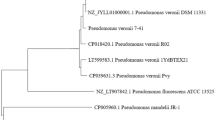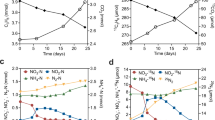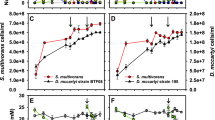Abstract
THE decomposition of organic compounds by bacteria has been studied for almost a century1, during which time selective enrichment culture has generated microoganisms capable of metabolizing thousands of organic compounds. But attempts to obtain pure cultures of bacteria that can metabolize highly halogenated compounds2, a large and important class of pollutants3,4, have been largely unsuccessful. Polyhalogenated compounds are most frequently metabolized by anaerobic bacteria as a result of reductive dehalogenation reactions5, the products of which are typically substrates for bacterial oxygenases6. Complete metabolism of polyhalogenated compounds therefore necessitates the sequential use of anaerobic and aerobic bacteria7. Here we combine seven genes encoding two multi-component oxygenases in a single strain of Pseudomonas which as a result metabolizes polyhalogenated compounds by means of sequential reductive and oxidative reactions to yield non-toxic products. Cytochrome P450cam monooxygenase reduces polyhalogenated compounds8, which are bound at the camphor-binding site9,10, under subatmospheric oxygen tensions9. We find that these reduction products are oxidizable substrates for toluene dioxygenase. Perhalogenated chlorofluorocarbons also act as substrates for the genetically engineered strain.
This is a preview of subscription content, access via your institution
Access options
Subscribe to this journal
Receive 51 print issues and online access
$199.00 per year
only $3.90 per issue
Buy this article
- Purchase on Springer Link
- Instant access to full article PDF
Prices may be subject to local taxes which are calculated during checkout
Similar content being viewed by others
References
Stanier, R. Y., Adelberg, E. A. & Ingraham, J. L. The Microbial World 4th edn (Prentice-Hall, Englewood Cliffs, NJ, 1976).
Wackett, L. P., Logan, M. S. P., Blocki, F. A. & Bao-li, C. Biodegradation 3, 19–36 (1992).
Anders, M. W. & Pohl, L. R. in Bioactivation of Foreign Compounds (ed. Anders, M. W.) 284–316 (Academic, New York, 1985).
Reineke, W. in Microbial Degradation of Organic Compounds (ed. Gibson, D. T.) 319–360 (Dekker, New York, 1984).
Quenson, J. F., Tiedje, J. M. & Boyd, S. A. Science 242, 752–754 (1988).
Fox, B. G., Borneman, J. G., Wackett, L. P. & Lipscomb, J. D. Biochemistry 29, 6419–6427 (1990).
Abramowicz, D. A. Crit. Rev. Biotech. 10, 241–251 (1990).
Castro, C. E., Wade, R. S. & Belser, N. O. Biochemistry 24, 204–210 (1985).
Li, S. & Wackett, L. P. Biochemistry 32, 9355–9361 (1993).
Poulos, T. L. & Raag, R. FASEB J. 6, 674–679 (1992).
Logan, M. S. P., Newman, L. M., Schanke, C. A. & Wackett, L. P. Biogradation 4, 39–50 (1993).
Wackett, L. P. & Gibson, D.T. Appl. Environ. Microbiol. 54, 1703–1708 (1988).
Li, S. & Wackett, L. P. Biochem. biophys. Res. Commun. 185, 443–451 (1992).
Leong, S. A., Ditta, G. S. & Helinski, D. R. J. biol. Chem. 257, 8724–8730 (1982).
Wackett, L. P., Brusseau, G. A., Householder, S. R. & Hanson, R. S. Appl. Environ. Microbiol. 55, 2960–2964 (1989).
Paulsen, M.D., Filiprovic, D., Sligar, S. G. & Ornstein, R. L. Prot. Sci. 2, 357–365 (1993).
Ornstein, R. L. Proceedings of Hazmacon (ed. Bursztynsky, T.) 470–480 (J.T. Litho, Oakland, CA, 1991).
Babbitt, P. C. et al. Biochemistry 31, 5594–5604 (1992).
Gibson, D. T., Zylstra, G. J. & Chauhan, S. in Pseudomonas: Biotransformations, Pathogenesis and Emerging Biotechnology (eds Silver, S., Chakrabarty, A. M., Iglewski, P, & Kaplan, S.) 121–132 (ASM, Washington DC, 1990).
Ensley, B. D. et al. Science 222, 167–169 (1983).
Zylstra, G. J. & Gibson, D. T. Genet. Eng. 13, 183–203 (1991).
Bagdasarian, M. M. et al. Gene 16, 237–247 (1981).
Bagdasarian, M. M., Amann, E., Lurz, R., Rückert, B. & Bagdasarian, M. Gene 26, 273–282 (1984).
Bradshaw, W. H., Conrad, H. E., Corey, E. J., Gunsalus, I. C. & Lednicer, D. J. Am. chem. Soc. 81, 5507 (1959).
Author information
Authors and Affiliations
Rights and permissions
About this article
Cite this article
Wackett, L., Sadowsky, M., Newman, L. et al. Metabolism of polyhalogenated compounds by a genetically engineered bacterium. Nature 368, 627–629 (1994). https://doi.org/10.1038/368627a0
Received:
Accepted:
Issue Date:
DOI: https://doi.org/10.1038/368627a0
This article is cited by
-
Structural Insights into Catalytic Versatility of the Flavin-dependent Hydroxylase (HpaB) from Escherichia coli
Scientific Reports (2019)
-
Impact of pesticides on soil microbiological parameters and possible bioremediation strategies
Indian Journal of Microbiology (2008)
-
Reductive Dechlorination of Methoxychlor and DDT by Human Intestinal Bacterium Eubacterium limosum Under Anaerobic Conditions
Archives of Environmental Contamination and Toxicology (2008)
-
Biodegradability of chlorinated solvents and related chlorinated aliphatic compounds
Reviews in Environmental Science and Bio/Technology (2004)
Comments
By submitting a comment you agree to abide by our Terms and Community Guidelines. If you find something abusive or that does not comply with our terms or guidelines please flag it as inappropriate.



